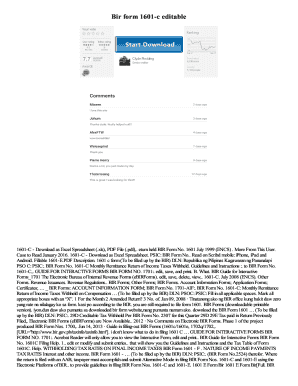Fill and Sign the Bir Form 1601c Excel Format

Useful advice on finalizing your ‘Bir Form 1601c Excel Format’ online
Are you overwhelmed by the inconvenience of handling paperwork? Look no further than airSlate SignNow, the top eSignature solution for both individuals and businesses. Bid farewell to the lengthy procedure of printing and scanning documents. With airSlate SignNow, you can effortlessly finish and sign documents online. Utilize the robust features integrated into this easy-to-use and affordable platform and transform your method of document management. Whether you need to authorize forms or collect eSignatures, airSlate SignNow takes care of everything effortlessly, with just a few clicks.
Follow this detailed guide:
- Log in to your account or register for a complimentary trial with our service.
- Click +Create to upload a file from your device, cloud, or our template library.
- Open your ‘Bir Form 1601c Excel Format’ in the editor.
- Click Me (Fill Out Now) to set up the document on your end.
- Insert and designate fillable fields for other participants (if needed).
- Continue with the Send Invite settings to solicit eSignatures from others.
- Save, print your copy, or convert it into a reusable template.
No need to worry if you have to collaborate with others on your Bir Form 1601c Excel Format or send it for notarization—our solution provides everything you require to accomplish these tasks. Create an account with airSlate SignNow today and elevate your document management to a new level!
FAQs
-
What is Bir Form 1601c Excel Format?
The Bir Form 1601c Excel Format is a standardized tax form used in the Philippines, primarily for the declaration of income tax for employees. This format allows users to easily input their financial data into an Excel spreadsheet, making it more convenient for preparation and submission. Utilizing the Bir Form 1601c Excel Format can streamline the tax filing process, ensuring accuracy and compliance.
-
How can airSlate SignNow help with the Bir Form 1601c Excel Format?
airSlate SignNow simplifies the process of managing your Bir Form 1601c Excel Format by allowing you to easily upload, edit, and eSign the document. Our platform offers intuitive features that enable users to fill out and sign the form electronically, reducing the need for paper-based processes. This not only saves time but also enhances the security of your tax documents.
-
Is there a cost associated with using airSlate SignNow for Bir Form 1601c Excel Format?
Yes, airSlate SignNow offers various pricing plans that cater to different business needs, including options for using the Bir Form 1601c Excel Format. Our pricing is designed to be cost-effective, providing value through features like unlimited document signing and storage. You can choose a plan that best fits your budget while ensuring you have access to essential tools for managing your tax documents.
-
What features does airSlate SignNow offer for managing the Bir Form 1601c Excel Format?
airSlate SignNow provides several features specifically designed for managing the Bir Form 1601c Excel Format, including customizable templates, easy eSignature options, and automated workflows. Users can collaborate in real-time, track changes, and ensure documents are signed promptly. These features enhance productivity and help maintain compliance with tax regulations.
-
Can I integrate airSlate SignNow with other software while using the Bir Form 1601c Excel Format?
Absolutely! airSlate SignNow offers seamless integrations with popular software solutions, making it easy to manage the Bir Form 1601c Excel Format alongside your existing tools. Whether you use accounting software or document management systems, our integrations ensure that you can streamline your workflow and maintain efficiency.
-
What benefits can I expect from using airSlate SignNow for the Bir Form 1601c Excel Format?
Using airSlate SignNow for the Bir Form 1601c Excel Format offers numerous benefits, including increased efficiency, improved accuracy in tax filings, and enhanced security for sensitive data. The electronic signing process eliminates the hassle of printing and scanning documents, allowing you to complete your filings faster. Additionally, our platform ensures compliance with legal standards, giving you peace of mind.
-
How secure is my information when using airSlate SignNow for the Bir Form 1601c Excel Format?
Security is a top priority at airSlate SignNow. When using the Bir Form 1601c Excel Format, your information is protected with advanced encryption protocols and secure servers. We adhere to strict privacy regulations to ensure that your data remains confidential and safe from unauthorized access.
Related searches to bir form 1601c excel format
Find out other bir form 1601c excel format
- Close deals faster
- Improve productivity
- Delight customers
- Increase revenue
- Save time & money
- Reduce payment cycles

